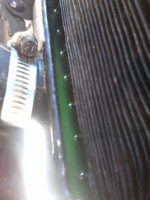Just wanted to pass that along. What is interesting in the article is what it states on distilled H20. "Generally distilled water is not used, as it tends to be
"hungry water" looking for ions, creating more problems that it solves." So living in Socal and what Larry points out about our H20...finding some w/o added minerals is the next best thing.
Two of my recent radiator changes started to show signs of electrolysis so I got the straps on. Going to source the correct diode for the one way ground when I have time. My gmc has high mileage on a 1 year old radiator which was leaking where the tubes go into the tank. Put the gunk aluminum pixie dust in there with good results.
Another tip is to paint the radiator so road salt and contaminants corrosive effects work both sides. You can use bbq paint or I have had great results with thermal dispersant (link below) which raises the efficiency of your radiator by 20%. The new formula doesn't need to be baked on.
http://techlinecoatings.com.au/product/tltd-thermal-dispersan
This coolant is another recommendation for mixing cast iron and aluminum.
http://www.nissanraceshop.com/product/genuine-nissan-blue-long-life-antifreezecoolant-1-gallon/
Supposedly GM adds these prior to shipping their vehicles.
https://www.amazon.com/Genuine-3634621-Cooling-System-Tablet/product-reviews/B000QIH3C4


